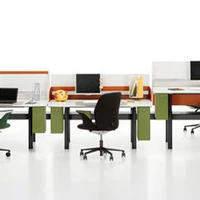Net’n'Nest
In 2006 Net’n'Nest was presented by Vitra at the Orgatec exhibition in Cologne as a pioneering solution to the open plan office, which had until then had the highly negative image, at least in Europe. Net’n'Nest enables the requirements of collective work in teams (Net) and of individual requirements for concentration, privacy, separation and differentiation (Nest) to be balanced.
September 29, 2008 | 10:00 pm CUT
In 2006 Net’n'Nest was presented by Vitra at the Orgatec exhibition in Cologne as a pioneering solution to the open plan office, which had until then had the highly negative image, at least in Europe. Net’n'Nest enables the requirements of collective work in teams (Net) and of individual requirements for concentration, privacy, separation and differentiation (Nest) to be balanced. At the same time great importance is allocated to 'taking a break from work', which is intended to promote creativity.

Over the past two years a large number of Net’n'Nest offices have been created for prestigious companies such as Accenture, Sony and Vodaphone, and initial experiences have been acquired with their use. A part of the concept is close corporation between Vitra and the customer, cooperation which goes well beyond selling and installing the system and covers detailed monitoring of its acceptance and the increases in productivity it may achieve.

These evaluations have also been the starting point for the further development of the Net’n'Nest concept. So far it has been necessary to move to different parts of the office for the implementation of the Net’n'Nest functions. The new challenge was to implement this change of location and with it the possibility of privacy at one and the same workstation. The result is the office furniture system 'Playnes', which is designed to carry out the entire range of Net’n'Nest functions by simple changes in height. Motorised, height adjustable table tops with fixed filing containers attached to them and surrounding screens serve to define the workstation. Workstations are grouped in pairs facing each other and rest only on four legs , connected by the central cable duct. Of course this double workstation unit can be freely extended along the cable duct.

The 'Playnes' concept was preceded by research which analysed the signals that are communicated by a person standing at the workstation and by someone who is sitting down. This analysis shows that standing means 'open for communication', while sitting down signals concentration. How this concept of parallel meetings and concentrated work in close proximity will function if a greater number of people are involved, as is shown in the 'workbench' configuration, still has to be demonstrated in practice.

The fact that Vitra is presenting a condensation of the Net’n'Nest concept is without a doubt partly a reaction to the office furniture market. Whereas the Net’n'Nest concept still required a relatively large amount of space, with 'Playnes' this area is now reduced to an absolute minimum.

Time is money, and the same principle applies to space. Only the future will show if Vitra is working on the right lines with this synthesis of traditional open plan and the individual work station.
Project Gallery






